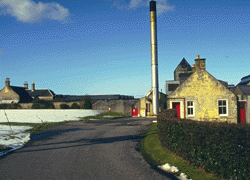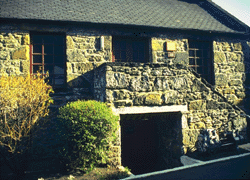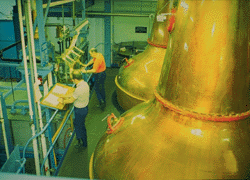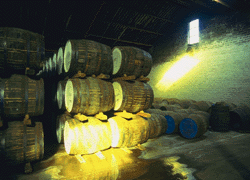
 Aeneas
MacDonald lists Glenburgie in his classic book 'Whisky', as one
of his twelve great malts. But despite this notable tribute, the
distillery itself is surprisingly inconspicuous, quietly nestled
for over 180 years in a wooded valley, surrounded by typical
Morayshire farmland. Its soot covered roof tops are barely
noticeable from the busy Aberdeen/Inverness road which lies just
a few minutes' drive away. Nevertheless once at the distillery it
is easy to see why a 'great' malt might be produced here. The
natural surroundings alone are invigorating, with the salt filled
air, blowing fresh from the Moray coast and the fine view that
the distillery commands of the impressive northern hills.
Aeneas
MacDonald lists Glenburgie in his classic book 'Whisky', as one
of his twelve great malts. But despite this notable tribute, the
distillery itself is surprisingly inconspicuous, quietly nestled
for over 180 years in a wooded valley, surrounded by typical
Morayshire farmland. Its soot covered roof tops are barely
noticeable from the busy Aberdeen/Inverness road which lies just
a few minutes' drive away. Nevertheless once at the distillery it
is easy to see why a 'great' malt might be produced here. The
natural surroundings alone are invigorating, with the salt filled
air, blowing fresh from the Moray coast and the fine view that
the distillery commands of the impressive northern hills.
The distillery was actually founded as long ago as 1810 and even when Alfred Barnard visited it in 1887, he described Glenburgie in his book 'Whisky Distilleries of the United Kingdom', as "a very ancient distillery, and about as old-fashioned as it is possible to conceive". Over the years a number of people have had ownership of Glenburgie but in 1936 it was bought by Ballantines, since when it has been an important part of Ballantines and Old Smuggler Blended whisky. The distillery was, in fact, quite unique around this time in that it had a manageress, Miss Nicol. Very few women have aspired to such a position, with one other notable example being Miss Bessie Williamson, Owner and Manager of Laphroaig Distillery. Glenburgie Distillery is now under the ownership of Allied Distillers.
 Today, the
distillery admirably combines old with new. Some of the original
buildings still stand, including a small building that used to
house the original manager's office, the excise office and an
incredibly small warehouse by today's standards. Indeed, whilst
rebuilding and upgrading have taken place over the years the
layout today is very similar to that of the original plan.
Nonetheless our tour of the distillery, lead by Distillery
Manager, Mr. Brian Thomas, proved beyond doubt that Glenburgie is
very much an effectively working modern distillery.
Today, the
distillery admirably combines old with new. Some of the original
buildings still stand, including a small building that used to
house the original manager's office, the excise office and an
incredibly small warehouse by today's standards. Indeed, whilst
rebuilding and upgrading have taken place over the years the
layout today is very similar to that of the original plan.
Nonetheless our tour of the distillery, lead by Distillery
Manager, Mr. Brian Thomas, proved beyond doubt that Glenburgie is
very much an effectively working modern distillery.
Of all of the distilleries that we have visited, each has had
a very individual character and, Glenburgie is no exception. One
lasting impression is of the compact layout of the whisky
production area, in stark contrast to the vast warehousing
capacity. The whole production process is undertaken in a
relatively small area, from the storage of the malted barley
through to the distillation of the spirit. Obviously planned to
achieve optimum efficiency, only two men are required to work in
this part of the distillery at any one time.
Within the whisky making process, numerous factors combine to create the very individual style of each malt and the choice of malted barley is as important as any. Brian Thomas explained that the barley selected for Glenburgie is very lightly peated, which contributes to its sweet, estery style and delicate flavour. The distillery used to have a floor maltings, but this was discontinued in 1958. Now the malted barley is brought in from maltsters in the local area and sometimes further south. Huge silos store up to 276 tons of malted barley, from where it is weighed and screened for any impurities and then ground finely in a Porteous malt mill, in such a way as to achieve maximum extraction of sugars in the mash tun.
During his visit to the distillery in 1887, Alfred Barnard described the mash tun as being ten feet in diameter by three and a half feet deep. To accommodate today's requirements the traditional copper-domed mash tun is some 16 feet in diameter and five feet deep, with a capacity of five tons. The ground barley, known as grist, is infused with warm water - the temperature of 63.5 degrees being critical. Also critical is the source of the water and at Glenburgie it comes from a spring situated in the grounds of the distillery. By contrast, the water used for cooling purposes comes from the distillery's own dam, fed by a nearby stream, and then recycled back into the dam to be used again.
The contents of the mash tun are pumped through to one of the thirteen washbacks, of which seven are stainless steel and six are of the more traditional wooden style. Each has a capacity of 23,500 litres. Here yeast is added and fermentation takes about 48 hours in total, although probably about 99% of the fermentation will have taken place after just 24 hours. At Glenburgie a combination of brewers yeast and fresh yeast from four different suppliers is used, which contributes to the final complexity in flavour of the malt.
Every five and a three quarter hours, half a wash charge is filled into a wash still, which has a capacity of 18,000 litres, and the low wines boiled off. Eleven and a half hours later two quantities of low wines are mixed with one quantity of foreshots and one quantity of feints and this goes to the spirit still for a further eleven and a half hours.
 Alfred Barnard writes of
'two sma' Pot stills, but there have been a number of changes
since his time. The distillery operated with one pair of stills
for many years, but in 1958 a pair of 'Lomond' Stills were added.
For a time, the distillery was actually producing two different
whiskies, Glenburgie, and another malt, known as Glencraig, which
was named after Mr William Craig, production director of
Ballantines at that time. He was actually one of the few men to
have a single malt named after him. Some Glencraig can still be
found but it is unlikely to be distilled again as in 1981 the
Lomond Stills were replaced by a pair of conventional pot stills.
Limited quantities of this very rare malt are available under
Gordon & MacPhail's Connoisseurs Choice label.
Alfred Barnard writes of
'two sma' Pot stills, but there have been a number of changes
since his time. The distillery operated with one pair of stills
for many years, but in 1958 a pair of 'Lomond' Stills were added.
For a time, the distillery was actually producing two different
whiskies, Glenburgie, and another malt, known as Glencraig, which
was named after Mr William Craig, production director of
Ballantines at that time. He was actually one of the few men to
have a single malt named after him. Some Glencraig can still be
found but it is unlikely to be distilled again as in 1981 the
Lomond Stills were replaced by a pair of conventional pot stills.
Limited quantities of this very rare malt are available under
Gordon & MacPhail's Connoisseurs Choice label.
Glenburgie has an aura of a traditional malt distillery, which has become at one with its natural surroundings. The tidy lawns around the distillery blend easily into the surrounding farmland. Despite the fact that during our visit the snow still lingered on the grass and glowed appealingly on the surrounding hills, we saw the first signs of the changing season, with new lambs frolicking in a nearby field. The Distillery has obviously been witness to many such changing seasons in which time it has consistently produced malt whisky of discernible quality. Fortunately, with the authority of the distillery owners, Gordon & MacPhail have been able to capture some of the history of the distillery in their bottlings of Glenburgie single malt, now at three different ages.
Read our tasting notes for Glenburgie Whisky.
Return to News Archive
Home | History | Sample Room | News | Product Range | Shop